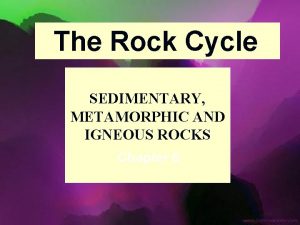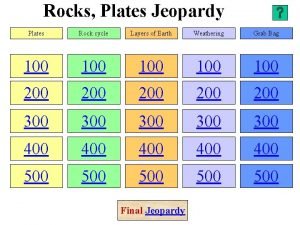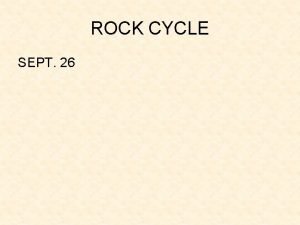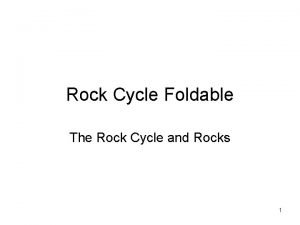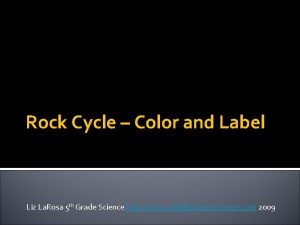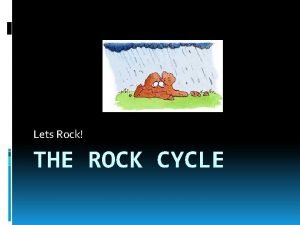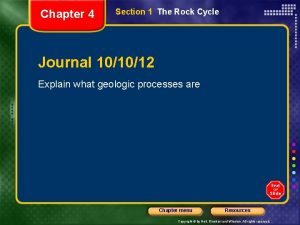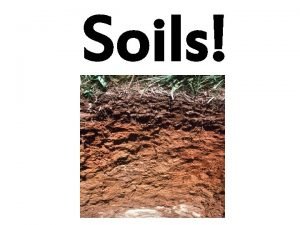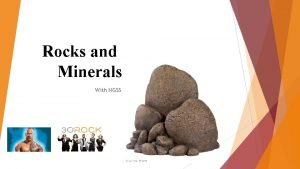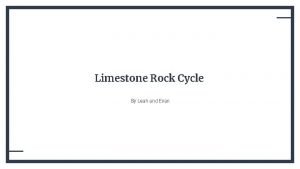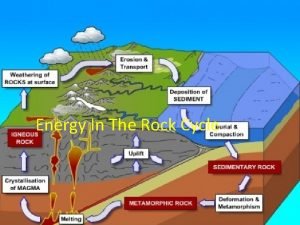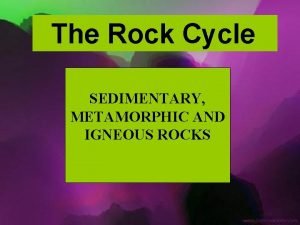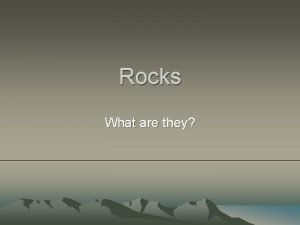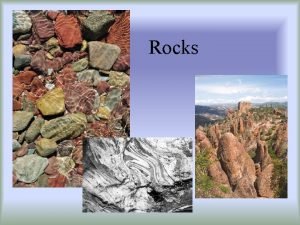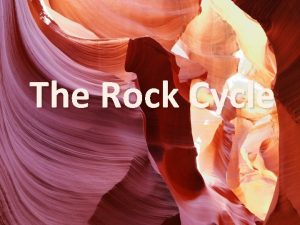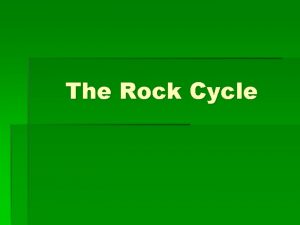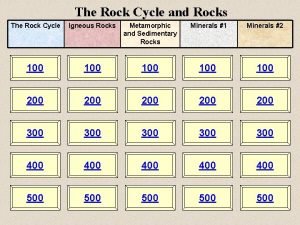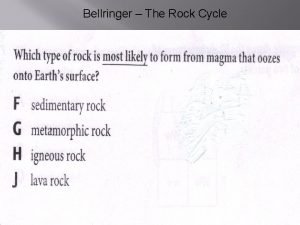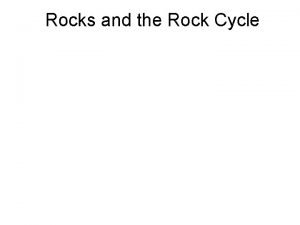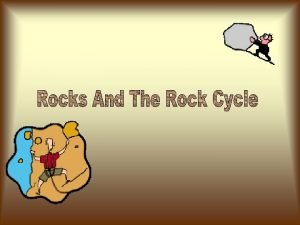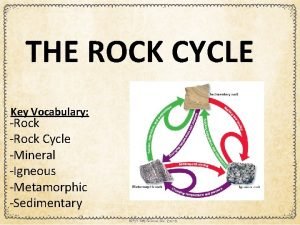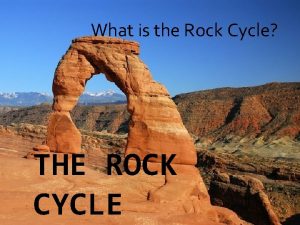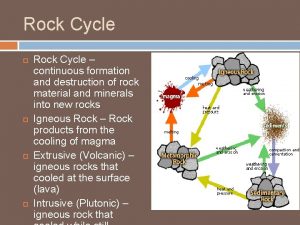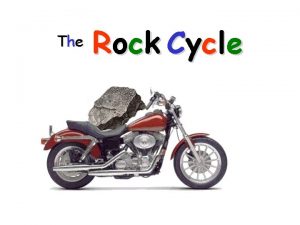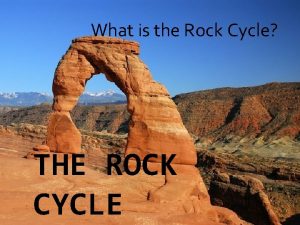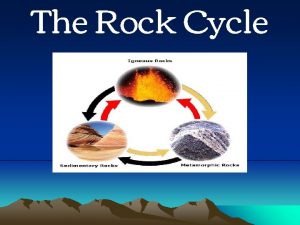The Rock Cycle The Rock Cycle is the
































- Slides: 32

The Rock Cycle

The Rock Cycle …is the natural process that rocks in the Earth's crust go through, that involves them continuously transforming into igneous, sedimentary, and metamorphic rocks.

What is a Rock? • Naturally Occurring (not man made) • Solid • Mixture of minerals and organic matter

What makes a rock different from a mineral? Rock Both Mineral Made of one or more minerals Solid Made of 1 type of element Random crystal or no crystal structure Naturally Occurring Orderly crystal structure Quartz Granite = Feldspar Muscovite

Types of Rocks Metamorphic: Gneiss Sedimentary: Sandstone Igneous: Diorite

Igneous Rocks

Igneous Rocks are formed from Magma and Lava Igneous rocks are classified by where they form Intrusive forms when magma cools in the Earth vs. Extrusive forms when lava cools on Earth’s surface

Intrusive Vs. Extrusive Diorite Granite Basalt Pegmatite Gabbro Rhyolite Andesite Scoria

Igneous Rocks: Crystal Size and Cooling Time Location of Rock Crystal Size Intrusive (in earth) Extrusive (earth surface) Large crystals Small crystals Longer cooling time Shorter cooling time Picture Cooling time

Sedimentary Rocks

Sedimentary Rocks form from sediment or rock particles Sediment = material that is deposited by air, water, or ice. These materials can be: ▪ tiny pieces of rock ▪ broken minerals ▪ pieces of plants and animal remains

How do sedimentary rocks form? • Sediments pile on top of each other on land or in water. • As sediments pile, they become compacted and cemented together. • This forms cemented layers of sediment.

Sedimentation Process

Sedimentary Rock Layers

Sedimentary Rock Layers

Some rocks form from plants or shells • Coal- created from the remains of plants (dead wood, bark, leaves, stems, and roots) • The coal we use today started forming millions of years ago in swamps • Limestone- created from the shells and skeletons of ocean organisms.

Limestone Formation

Metamorphic Rocks

Metamorphic Rocks Extreme heat and pressure can change rocks. • The original rock is called the parent rock • The new rock formed is called the metamorphic rock • Heat and pressure change the structure of the parent rock and their minerals recrystallize

Examples of Metamorphic Rocks Extreme heat and pressure Parent Rock Shale Metamorphic Rock Slate

Examples of Metamorphic Rocks Extreme heat and pressure Parent Rock Limestone Metamorphic Rock Marble

Examples of Metamorphic Rocks Extreme heat and pressure Parent Rock Mica Metamorphic Rock Phyllite

A little bit more about igneous rocks… Granite Rhyolite

IGNEOUS ROCKS BASALT GABBRO

Composition of Igneous Rocks Igneous rocks are mainly composed of silicate minerals (quartz, feldspar, etc. ) • Rocks with high silicate levels-are typically light in color • ex: granite, rhyolite • Rocks with low silicate levels- dark in color • ex: gabbro and basalt

Igneous rocks make long-lasting landforms 1. Intrusive rock formations-as magma pushes up toward Earth’s surface, it makes channels and other formations underground. 2. Extrusive rock formations • builds plateaus when erupting from long crack • gently sloping volcanoes (Hawaiian islands) • cone-shaped volcanoes (1). contains greater amount of silica (2). erupts explosively (3). Mount St. Helens is an example

RECAP: • Rock cycle-the set of natural processes that form, change, break down, and reform rocks

When a rock forms, does it stay that way forever? NO!!!!!! Rocks are always changing by processes like: • Weathering • Melting • Erosion • Cooling • Compaction • Cementation

Our world is built of rocks Rocks have many purposes 1. used to build houses and skyscrapers 2. great source of metals 3. used to carve statues and other works of art


11. Rock Cycle

Rock Cycle animation
 Rock cycle
Rock cycle Rock cycle
Rock cycle Igneous rock to metamorphic rock
Igneous rock to metamorphic rock Bungee climbing
Bungee climbing Chapter 3 standardized test practice answers
Chapter 3 standardized test practice answers Chapter 3 standardized test practice answers
Chapter 3 standardized test practice answers Metamorphic rock to sedimentary rock
Metamorphic rock to sedimentary rock Rock cycle comic strip
Rock cycle comic strip Rock cycle song for kids
Rock cycle song for kids Sedimentary rock properties
Sedimentary rock properties Rock cycle jeopardy
Rock cycle jeopardy Song about igneous rocks
Song about igneous rocks Rock cycle explanation and diagram
Rock cycle explanation and diagram Kesler rock cycle
Kesler rock cycle Types of rocks foldable
Types of rocks foldable Rock cycle coloring
Rock cycle coloring Map of igneous rock
Map of igneous rock Rock cycle doodle notes
Rock cycle doodle notes Jeopardy rock cycle
Jeopardy rock cycle Chapter 4 section 3 sedimentary rock answer key
Chapter 4 section 3 sedimentary rock answer key Lesson 2 the rock cycle answer key
Lesson 2 the rock cycle answer key Rock cycle
Rock cycle Deformation rock cycle
Deformation rock cycle How does soil link the rock cycle and biosphere
How does soil link the rock cycle and biosphere Transportation in rock cycle
Transportation in rock cycle Rock cycle ngss
Rock cycle ngss Rock cycle project
Rock cycle project Limestone rock cycle
Limestone rock cycle Rock cycle
Rock cycle Igneous rock comic strip
Igneous rock comic strip It was a sedimentary rock song
It was a sedimentary rock song Rock cycle
Rock cycle Learner.org rock cycle
Learner.org rock cycle








